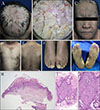Dear Editor:
Darier's disease is a rare autosomal dominant genodermatosis, histopathologically characterised by acantholytic dyskeratosis1. It clinically presents as brownish greasy hyperkeratotic papules coalescing into warty plaques in seborrheic areas, like the scalp, face, and upper trunk2. Scalp involvement may be severe, but scarring alopecia and pityriasis amiantacea-like scales are rare3. We describe a rare case of Darier's disease with concurrent pityriasis amiantacea in a patient with follicular lymphoma. We received the patient's consent form about publishing all photographic materials.
A 54-year-old man presented with a 10-year history of scaly, warty papules coalescing into plaques on the majority of his body. Lesions began on his face, scalp, upper chest, and back. They gradually spread to his trunk (Fig. 1A~E). He had localized hair loss with masses of sticky silvery scales that exihibited keratotic papules coalescing into warty plaques clinically on the scalp, and trichoscopy revealed missing follicular orifices (Fig. 1A, B). His toenails showed yellowish dystrophic changes, severe subungual hyperkeratosis, and thickened nail plates (Fig. 1F). He had pain in his feet from hyperkeratotic plaques with keratin-filled pits covering the surfaces of his soles (Fig. 1G). He had no family history or neuropsychological problem, including psychosis and epilepsy. He received cyclic chemotherapy with rituximab-cyclophosphamide, vincristine, prednisolone for follicular lymphoma (WHO grade III), diagnosed by haemato-oncology, 7 years ago, during evaluation of a palpable neck nodule.
Histopathology showed hyperkeratosis, acanthosis, papillomatosis, suprabasal clefts, and dyskeratotic cells in the epidermis, and a moderate perivascular inflammatory dermal infiltrate (Fig. 1H~J). A diagnosis of Darier's disease with concurrent pityriasis amiantacea was made by clinicopathological correlation. Treatment with oral acitretin (20~30 mg/day reduced scaling, papules, and pain in his soles.
Pityriasis amiantacea characterised by thick, silvery, adherent, asbestos-like scales, surrounding hair tufts3 could be associated with inflammatory dermatoses, viz., psoriasis, seborrheic dermatitis, and fungal or pyogenic infections. Pityriasis amiantacea due to Darier's disease has rarely been reported, and a 12-year-old girl has shown pityriasis amiantacea as the only clinical manifestation of Darier's disease with characteristic spiny heavy scalp crusting3. Scalp hair is usually preserved in Darier's disease, but scarring alopecia is known in severe cases. The present case showed sticky silvery scales that caused matting of hairs they surround with a worm-eaten appearance on the scalp.
Association of Darier's disease with malignancy has rarely been reported45. Cases with underlying Hodgkin's lymphoma4 and stomach cancer5 are known. It is hypothesised that cancer-producing cytokines such as transforming growth factor-β affecting cellular calcium homeostasis, lead to Darier's disease as a paraneoplastic syndrome5. In our case, skin manifestations preceded the oncologic manifestations, and did not correspond to any haematological malignancy (clinical course, or skin response to oncologic chemotherapy). Thus, its association with follicular lymphoma was considered a coincidental finding rather than it being a kind of paraneoplastic syndrome. In conclusion, our case suggests that pityriasis amiantacea might be a clinical manifestation of Darier's disease.
Figures and Tables
 | Fig. 1(A) Asbestos-like, adherent scales on the scalp. (B) Loss of follicular orifices in trichoscopy. (C~E) Scaly, warty papules that coalesce to form plaques on face, upper chest, back. (F) Yellowish dystrophic toenails with severe subungual hyperkeratosis, thickened nail plate. (G) Hyperkeratotic plaques with keratin-filled pits covering almost entire surfaces of both soles. (H) Hyperkeratosis, acanthosis, papillomatosis in epidermis, and moderate perivascular inflammatory infiltrate in dermis (H&E, ×40). (I, J) Suprabasal clefts, and dyskeratotic cells that shows small pyknotic nucleus and clear perinuclear halo (H&E: I, ×200; J, ×400). |
References
1. Chung J, Kim JY, Gye J, Namkoong S, Hong SP, Park BC, et al. A case of familial comedonal Darier's disease. Ann Dermatol. 2011; 23:Suppl 3. 398–401.

2. Cooper SM, Burge SM. Darier's disease: epidemiology, pathophysiology, and management. Am J Clin Dermatol. 2003; 4:97–105.
3. Hussain W, Coulson IH, Salman WD. Pityriasis amiantacea as the sole manifestation of Darier's disease. Clin Exp Dermatol. 2009; 34:554–556.





 PDF
PDF ePub
ePub Citation
Citation Print
Print



 XML Download
XML Download